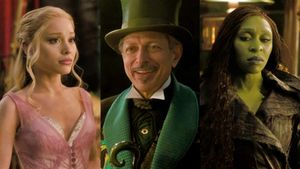Wildly inventive and yet rigorous in its adherence to themes of metamorphosis, mirroring, dopplegangers and loss of identity, Darren Aronofsky’s thriller in point shoes, Black Swan, released in select cities today, swoops in with its first, singular shot, and holds focus as its star sheds – or rather – molts every layer of reality from her psyche.
Teetering on the brink of high camp but never quite going there, Aronofsky’s Oscar bait endeavor, starring Natalie Portman as a featured ballerina spinning out of control from reality, is firmly rooted in the stuff of celluloid greatness, often paying homage to Hitchcockian themes and with echoes of David Cronenberg’s fetish with the permeability of the flesh, as exhibited by close-ups of dancers’ feet shown battered, bruised and torn asunder in excruciating detail.
While much ado has been made in the LGBT community about the film’s lesbian subtext and love scene – and it is titillating -- Aronofsky delivers so much more in a modern-day story about the ballet that is at-once pristinely acted, visually stunning and a thoughtful exercise in filmic tropes from the suspense and horror genres - and of course with a nod to the ballet classic The Red Shoes.
Aronofsky, who became a film festival darling with Requiem for a Dream and an Oscar contender for the brutal and heart-rending Mickey Rourke starrer The Wrestler -- an update of the Frankenstein story of sorts – makes use of several of that film’s themes in Black Swan, including an obsession with the trappings of grueling physical performance.
While Black Swan’s lead character Nina Sayers suffers from a fractured identity, the film’s mise en scene is firmly fixed in a black and white color palette, including the dancers’ costumes, dress at a black and white reception, the bleak interiors of the NY Subway system and the halls of the fictitious ballet company, which is under the direction of Vincent Cassel’s smarmy but brilliant Thomas.
The film’s opening sequence has Portman’s Nina, at first elegantly, and then furiously, dancing to an updated version of Swan Lake, replete with a feathered and masked aggressive male suitor. Next, Nina wakes up in bed pondering the dream she’s just had. This dream / verging on a nightmare sequence sets the tone for the film in which reality and fiction and the subjective and objective are often difficult to discern. If there is a fixed element one can expect from Aronofsky’s unreliable narrator Nina, is that Nina’s loose grip on the reality from the outset, will only diminish throughout the course of the movie.
But Nina, an elegant, if not, tightly wound ballerina who unravels with just the slightest flick at her fragile psyche, has good cause to lose herself in the story in the ballet company’s reimagining of Swan Lake, which calls for a single dancer to perform the virginal white swan and the feral, sensuous black swan. When she’s not literally on point with the ballet company, Nina’s world is confined to the claustrophobic apartment she shares with her mother, a former dancer who has sacrificed all for her daughter’s success, played with brilliantly frightening ferocity by Barbara Hershey (virtually unrecognizable from her early success in films including Hannah and Her Sisters). If the ballet world is typified in clean black and white, Nina’s apartment with her mother is comprised of pink signifying Nina’s little girl bedroom and arrested development, and a sickly green in the spaces where her mother mainly resides.
The mother / daughter dynamic harkens to monstrous mothers from film history including Norman Bates’ posthumously controlling mother in Hitchcock’s Psycho. But an allusion to Psycho in the form of the mother is just the beginning of Aronofsky’s loving debt to Hitchcock, as Nina’s mother also doubles as Nina’s other self, and the idea of doubling or mirroring personalities is central to films including Rebecca, Kim Novak’s character in Vertigo and the male lead characters in Strangers on a Train.
More on next page...
\\\
(continued)
Once Nina leaves the puke green of her mother’s home she enters the lonely world of the NY subway system, laden with mirrors and reflection, where she encounters dark-haired girl after dark-haired girl, who all suddenly become versions of Nina in her mind. An ambitious dancer with visions of sharing the spotlight with no one, Nina sacrifices a piece of her chaste reputation to seek the lead role in Black Swan.
Without giving too much of the plot away, Nina lands the role, but to the detriment of the company’s lead ballerina, Beth, played with a wink and a nudge to her own troubled past by Winona Ryder. If Beth is another double for Nina and what could be a ghost of her Swan Lake future then the scintillating Mila Kunis’ Lily -- as the upstart wild child dancer fresh from a company in San Francisco – is also a double and the ghost of Nina’s Swan Lake present. Lily is everything Nina is not – free, sexually astute and she oozes eroticism while Nina relies on icy elegance, and Lily is ambitious enough to pose a threat to Nina’s success in the role.
Cue Nina’s rampant paranoia borne out of her insecurity and inability to be anything but her mother’s ‘sweet girl.’ A tenuous and not-to-be trusted friendship develops between Nina and Lily, inspiring Nina to take several stumbling baby steps out of her mother’s grasp and causing a rift with her mother and her primary relationship. The combination of straining to conquer the role as the Swan Queen, attempting a sensual awakening with a little help from Lily – one way or the other—and a break from her mother, sends Nina into a spiral from which there is no reasonable return. And Aronofsky makes certain that the viewer won’t know --until the final frame—just how far Nina’s sense of self has melded and / or split with all of her doubles, including her mother, Lily, Beth and the black swan.
To risk using an overused term, Portman is a tour de force, a shoo-in of an Oscar contender, who lays bare emotionally as much as she purportedly trained for five or six hours a day for more than a year to pull off the dancing sequences. At a sinewy 20 pounds lighter than her standard weight, Portman’s bone structure, so exquisitely filmed, lends to her outward fragility. Her Nina seems always on the verge of snapping – physically, mentally, emotionally. Her performance is a melding of physicality and craft that has scarcely been seen in Hollywood since Robert DeNiro's turn in Raging Bull.
With a developing auteur in Aronofsky, a riveting performance by Portman, strong supporting help with a whole lot of sensuality and verve thrown in by Kunis, and remarkable work by Cassel, Hershey and Ryder, Black Swan is that rare, visually pleasing film that continues to work it’s way under the skin with it’s thoughtful themes poking and playing with audience well after Swan Lake’s final curtain call.























































































 Cindy Ord/Getty Images
Cindy Ord/Getty Images

























